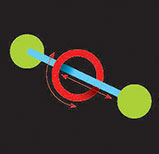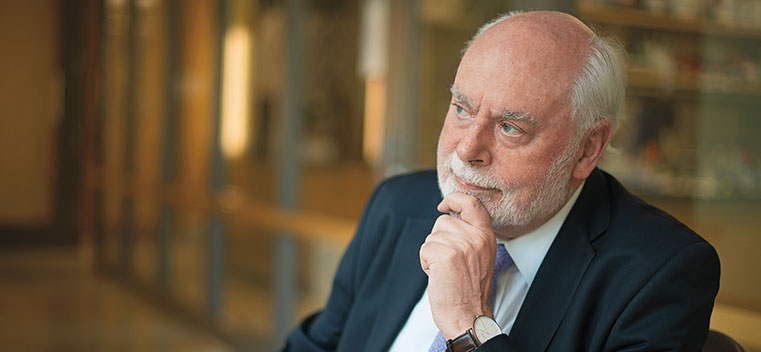
The Right Chemistry
Related Articles
Fraser Stoddart: Lighting Up Life on the Farm
Online Exclusive:
He’s No Slugabed
Online Exclusive:
Northwestern Nobels
Stephanie Russell is executive editor of Northwestern magazine.
Tell us what you think. E-mail comments or questions to the editors at letters@northwestern.edu.
Find Us on Social Media
J. Fraser Stoddart shared the 2016 Nobel Prize in Chemistry for his design and creation of molecular machines through mechanical bonding. But his first priority these days isn’t research — it’s training young chemists to blaze new trails in the nanoscience world.
Just before boarding a plane bound for Canada in 1967 (the first airplane trip of his life) to start a postdoctoral fellowship, 25-year-old J. Fraser Stoddart received a bit of advice from his PhD examiner at the University of Edinburgh, where he had just completed his doctorate in chemistry: “Stoddart, whatever you do, make sure you tackle a big problem,” advised Sir Edmund Hirst.
“I had no idea what he was talking about,” Stoddart recalls. “In many ways his words were ringing in my ears throughout that flight.”
But then Stoddart got lucky. He arrived at Queen’s University in Kingston, Ontario, to find out that his prearranged mentor was taking off on sabbatical to do research in Brazil for a year. So Stoddart was suddenly blessed with a great deal of independence as a postdoc, and he happily holed up in the university’s library in search of the big problem. Two months later he came across a paper in the Journal of the American Chemical Society written by DuPont laboratories scientist Charles Pedersen about the making of a very large ring with 18 atoms in it — it had six oxygens and 12 carbons.
“This blew my mind apart,” says Stoddart, Board of Trustees Professor of Chemistry at Northwestern’s Weinberg College of Arts and Sciences, “because my professors in Edinburgh had been saying, ‘You’ll never be able to make these things on a large scale. You can make six-membered rings, and even five- and seven-membered rings, but you can forget about the rest.’ Suddenly I was faced with the fact that, yes, you can do this.
“I began to realize that I had identified the big problem,” Stoddart says. “I knew that if you had a big enough ring of atoms, then you could open up the door for feeding something through it.”
Though it would take Stoddart many years to get from that realization to his discovery of the mechanical bond, he was on the right track. His passion for his “hobby” of chemistry would take him across three continents to teaching and research appointments at eight universities in England and the United States, as well as to visiting lecturer appointments in Brazil, France, Italy and Switzerland before landing him at Northwestern in 2008.
For a Scot who grew up on a post–World War II farm with horse-drawn carts — and no electricity until 1959 — and who would go on to build nanometer-sized molecular machines and then share the Nobel Prize in Chemistry in 2016, it has been an extraordinary journey. And through it all Stoddart has remained an inspiring and generous, yet demanding, professor who believes his most important work isn’t to do research but to mentor and train today’s students and postdocs to be the pathbreaking chemists of tomorrow.
![]()
Last October, Sir J. Fraser Stoddart, Bernard Feringa and Jean-Pierre Sauvage won the 2016 Nobel Prize in Chemistry for their design and synthesis of molecular machines, tiny moving machines about 10,000 times smaller than the width of a human hair. The three laureates have developed molecules with controllable movements that can perform a task when energy is added. (See a list of all Nobel Prize winners who have studied or taught at Northwestern or been awarded an honorary degree from the University.)
Feringa manipulated parts of molecules around carbon-carbon double bonds to create unidirectional rotary motors, while Sauvage and Stoddart introduced a new bond into chemistry — the mechanical bond — which has led to compounds composed of mechanically interlocked molecules in which the relative movements of their components can be controlled to produce linear motors.
As Stoddart so eloquently explained the significance of the bond in his Nobel Banquet speech in Stockholm last Dec. 10: “Chemistry welcomes into its fold thousands of new compounds every day. It’s only once in a blue moon that a new bond, which constitutes a game-changer, enters the chemical domain. The mechanical bond is such a bond.”
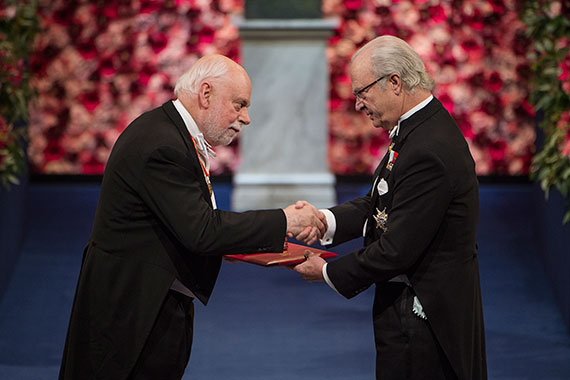
Sir J. Fraser Stoddart receives his Nobel Prize in Chemistry from King Carl XVI Gustaf of Sweden at the Stockholm Concert Hall on Dec. 10. For more on the Nobel festivities, see "Nobel Week." Photo courtesy of Nobel Media AB 2016/Pi Frisk.
![]()
There had been talk since 1993 that Stoddart was being considered for a Nobel, so every time the rumors flew, he would update his curriculum vitae, at the request of the press offices at the various universities where he was teaching. A few days before the announcement of the 2016 Nobel Prize in Chemistry, the Northwestern media relations department asked Stoddart to do the same. “Just tell them that there’s no need to update the press release; nothing’s happened that’s new. The Nobel Prize — it’s not going to happen,” Stoddart told his assistant, Margaret Schott ’78 MS, ’82 PhD.
When the phone rang at 4 in the morning on Oct. 5 last year, Stoddart had only been asleep in his northwest Evanston home for three hours. Upon learning from the caller that he had won the Nobel Prize in Chemistry, Stoddart’s first thought was that the call was a hoax. But as the person continued on with all the details, he recognized the distinct accent of a Swede speaking English. He was given about 20 minutes to tell his family before the Royal Swedish Academy of Sciences broke the news to the world at a press conference streamed live in Stockholm.
He made emotional phone calls to his daughters, both PhD chemists, Alison Stoddart, in Cambridge, England, and Fiona McCubbin, in Kobe, Japan. “Dad was crying, and so was I,” recalls Alison, editor of Nature Reviews Materials, who just happened to be looking up chemical structures in a textbook Fraser had written, for a project she was working on, when her father phoned. Fiona, her husband and two children had just finished dinner, after all being home uncharacteristically early because of a typhoon warning in Kobe. When Fraser called, Fiona says she let out a yelp, a cry and a sob all at once, which sent her kids running to her side.
But it was a bittersweet moment for Fraser not to be able to share the Nobel Prize news with his wife, Norma, a fellow chemist from Scotland, who died in 2004 after a 12-year battle with breast cancer.
“It wasn’t ultimately smells and bangs that took me to chemistry; it was the absolute beauty of the subject.” — J. Fraser Stoddart
MECHANICAL BONDS LEAD TO MOLECULAR MACHINES
It was another Nobel laureate, physicist Richard Feynman, who in 1959 first predicted a nanoscale world where scientists would be able to manipulate matter at an atomic and molecular scale.
See "Infographic: Explaining Molecular Machines"
Chemists were already building molecular chains in test tubes by the 1950s and ’60s, but the results were unimpressive. Normally molecules are held together by strong covalent bonds in which atoms share electrons. The chemists’ dream was to instead create a mechanical bond, where molecules are interlocked without the atoms interacting directly with each other.
In 1983 French chemist Jean-Pierre Sauvage made a major breakthrough: He and his research group constructed one ring-shaped and one crescent-shaped molecule, so that they were attracted to a copper ion; the copper ion provided a kind of cohesive force that held the molecules together. In a second step, the group used chemistry to weld together the crescent-shaped molecule with a third molecule to form a new ring, thus creating the first link in a chain (see illustration).
Sauvage realized that these molecular chains, called catenanes, were the first step in the creation of molecular machines.
Meanwhile Stoddart was on the same mission as he sculpted and designed molecules that are attracted to each other. A turning point came in 1989, when he and his research group created an organic catenane (two interlocked rings) that delivered an amazing 70 percent yield (the percentage of the initial molecules that form the target molecule). “For an all-organic catenane, this was a really big step,” he says. “It went from 0.1 percent [registered in the literature in 1960] to 70 percent. I told the members of my research group that ‘We’re at the entrance of a gold mine.’ Suddenly we were there.”
Stoddart’s next big breakthrough came about in 1991, when he and his research group at the University of Birmingham in England synthesized a rotaxane, a ring-shaped molecule that is mechanically attached to an axle (see illustration, opposite page). When he added heat, the ring moved back and forth on the axle between two electron-rich parts on the ends — like a tiny shuttle on a dumbbell. By 1994 Stoddart could completely control the movement of this molecular shuttle.
Since then Stoddart and his lab groups have used rotaxanes, based on mechanical bonds, to create numerous molecular machines, including an elevator and an artificial muscle.
THE IMPACT OF THE PRIZE
What has many scientists so thrilled about the 2016 Nobel Prize in Chemistry is that the Nobel Committee gave the award to three chemists doing extremely fundamental research, even though it’s not clear where their discoveries will take them.
“I think the mechanical interlocking is going to open up all kinds of possibilities for materials and, of course, applications,” Stoddart explains. “But we’ve a long way to go to get there. We’re just at the beginning of this odyssey.”
“There’s nothing technologically important about these discoveries — yet,” says Chad Mirkin, the George B. Rathmann Professor of Chemistry at Weinberg and director of Northwestern’s International Institute for Nanotechnology. “But they fundamentally changed the way you think about two things: One is how you put together matter — this concept of the mechanical bond changes the way you think about how molecular units are connected to one another; and two, the concept that you can build molecular machines by using this new type of mechanical bonding, and that there are machines, in a loose analogy, that look crudely like some of the components of the machines that we create in the macroscopic world.
“The Nobel Prize is in fact for these types of discoveries; it’s for changing the way you think about chemistry, the way you think about the world,” adds Mirkin. “Fraser and his colleagues changed the way we thought about bonding and in the process created this concept of molecular machines. Whether they lead to something technologically useful or not, we’ll have to wait and see.”
But some useful applications are indeed underway, says Carson Bruns ’13 PhD, who completed his doctorate in Stoddart’s lab at Northwestern. “Molecular machines and mechanical bonds have been used as valves to open and close the gates of drug delivery vehicles,” he explains. “They’re being used in targeted drug delivery. They’re also being used in molecular electronic devices. And they could help miniaturize electronics and computing devices even further.”
![]()
What inspired Stoddart to spend his life looking at molecules and bonds was unusual for a chemist.
“It wasn’t ultimately smells and bangs that took me to chemistry; it was the absolute beauty of the subject,” he says, “the fact that you are carrying out sculpturing, painting and composing at the subnanometer level.”
Stoddart points to the early influence of Celtic art and nature on his research. “Just looking at gravestones, Borromean rings or the Book of Kells and seeing how the Celtic culture has evolved a way of intertwining and interlacing and interlocking almost everything that they could, be it stone or metal — I was always conscious of this,” says Stoddart. “In nature we see bonds with a level of elegance, complexity and beauty that we chemists can only hold in awe, and that we’ll surely use as a source of inspiration for many years to come.”
HUMBLE ROOTS
Stoddart’s father caught the farming bug as a child, and after graduating from college in Glasgow, he became the manager of two farms owned by the University of Edinburgh.
Six months after Fraser was born in 1942, his parents decided to take on the tenancy of a 365-acre farm on the Rosebery Estate in Midlothian, about 12 miles south of Edinburgh.
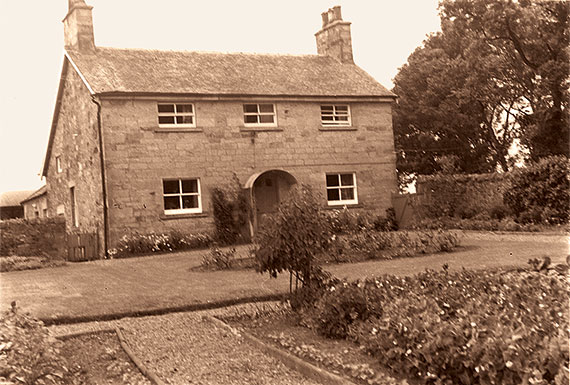
The tenant farmhouse where Fraser Stoddart grew up, on the Rosebery Estate in the council area of Midlothian, Scotland. Read "Lighting Up Life on the Farm," his firsthand account of bringing electricity to the farm at Christmastime in 1959.
As an only child, Stoddart helped his parents with chores from before sunup to well after sundown. There were dairy cows, cattle, “sheep of all different complexions” and hundreds of free-range chickens to care for. The family also grew everything from root crops to grain. And Stoddart was solely responsible for the fruit and vegetable garden.
With the arrival of the tractor and the car on the farm, he soon learned to take the simple and inefficient engines apart and put them back together.
“I had that wonderful time to watch a very big and fast change in technology up close,” says Stoddart. “So in literally 20 years we went from a horse-and-cart situation to combine harvesters with everything in between.
“The farm was very important to my training because it was multitasking on quite a large scale, particularly at high points of the year, such as March, when we were lambing, or in August and September, when we were bringing in the grain crops.”
In a letter to his daughter Fiona (excerpted below), Stoddart wrote of the significance of growing up on the farm and how it taught him discipline, resilience, resourcefulness and the nurturing of creatures great and small:
“I was present at lambings and calvings from quite a young age and was soon helping by myself to aid and abet the entry of lambs and calves into the world, particularly when it became a matter of life or death and the available work force was stretched to its limits and often close to exhaustion if the weather, as was often the case in that part of the world, decided to have its worst possible say. Wet snow was a killer, and very often newborn lambs had to be brought ’round from death’s door in the bottom oven of the Rayburn cooker in the farmhouse kitchen, while being fed hot cow’s milk laced with whisky! More often than not the lambs that survived this near-death experience were rejected by their mothers, and so the army of pet lambs that had to be fed by hand from bottles of milk four times a day grew to debilitating proportions.
“During my professional lifetime as an academic, teaching and doing scientific research in eight universities on three different continents, I have no hesitation in coming to the conclusion that I learnt a lot more during my first 25 years on the farm than I have at all the universities combined over the past 52 years.
“Indeed, any modest successes I have reaped thereafter can be traced back to the University of Life in the Lothians of Scotland in the ’40s, ’50s and ’60s as the country recovered gradually, under rationing in the beginning, from the devastation wrought by the Second World War.”
When Stoddart began his studies at the University of Edinburgh in 1960, he planned on a career in medicine but soon recognized he was much more interested in the sciences. “I was captivated by the wonder of making discoveries,” he recalls. “And I soon realized that, among the sciences, chemistry would give me, by far, the biggest opportunity to be creative. More than any other science, chemistry gives you the feeling of being able to pose problems and solve them.”
While finishing his undergraduate and doctoral studies in Edinburgh, Stoddart continued to live on the farm and help his parents, commuting to the city on a motor scooter.
When Stoddart left Scotland for a postdoctoral fellowship in Canada in 1967, it marked the end of the family’s farming days. His parents soon moved to Edinburgh, where his mother ran a successful bed-and-breakfast for a number of years.
FRASER’S PATH TO NORTHWESTERN
After finishing the Canadian fellowship, the young scholar landed his first academic position at the University of Sheffield in England in 1970.
The ’70s proved to be a stressful period for Stoddart, as he learned his way around academia. It was only after a three-year secondment, a fixed-term transfer to an external organization, at Imperial Chemical Industries Corporate Laboratory in Runcorn that he developed the assertive mindset, he says, that was necessary to advance in his academic career.
He moved on to the University of Birmingham in 1990, where he became chair of organic chemistry. It was a highly productive period for Stoddart and his lab, as they discovered the mechanical bond and created catenanes and rotaxanes.
But it was a long slog. “I have to emphasize that these early steps don’t happen quickly,” Stoddart says. “You make a lot of mistakes and go up a lot of blind alleys. We wasted two years on one thing. Some of our work was overdesigned. We had to try to do something that would be much faster and simpler. And in the end, we found that the simpler thing actually works.”
Stoddart headed to the University of California at Los Angeles in 1997 to teach organic chemistry and ultimately to become director of UCLA’s California NanoSystems Institute. His wife and right hand, Norma, a fellow chemist whom he had met at the University of Edinburgh, was fighting cancer during this time and died seven years later, after her own accomplished academic career.
“I wasn’t going to do something quickly in terms of leaving,” recalls Stoddart. “But I began to think, ‘I’ve got to leave this lair.’ It wasn’t so happy a feeling to go home at night — I often likened it to a fox without his mate. You feel that absence. Whereas if you move and create another home, then you have changed your whole psychology.”
Around this time Stoddart and UCLA had been interested in recruiting Northwestern chemistry professor Chad Mirkin, but when state funding dried up for UCLA’s nanotechnology research, Mirkin turned the tables on Stoddart and recruited him to Northwestern in 2007. (Stoddart arrived on campus in 2008.)
“A rising tide lifts all boats,” says Mirkin. “Fraser’s a special guy in that regard. He brought a level of enthusiasm and excellence to the chemistry department. He works his rear end off. This is his life: He eats, breathes and lives chemistry. And he has dramatically improved the careers of many young people in his own group and also young people at Northwestern who took the opportunity to learn from him.”
MENTORING
At the Swedish Embassy’s 2016 symposium with the U.S.-based Nobel laureates (except for Bob Dylan) in Washington, D.C., last November, Stoddart began his presentation by talking about the many forms of bonds that he saw in the audience around the room — necklaces, ties and rings — “we all get involved in bonding in a physical sense, throughout the day. It’s all about bonding.”
While Stoddart’s discovery of the mechanical bond — a new field in chemistry — is a remarkable advancement, there’s another form of bonding equally important to the researcher: human bonding, namely mentoring and bonding with his graduate students and postdocs.
Over the years he has mentored and taught more than 400 students at the various institutions where he has worked — and he thanked them all in his Nobel lecture last December by running their names across the screen at the end of his talk.
The mentoring started with his first teaching position at the University of Sheffield. His daughters recall that not only would their parents invite students to dinner, their dad would even bring some home to live with the family.
“Our dad’s students and postdocs have been his extended family ever since Sheffield,” says Fiona McCubbin. “It’s unusual how much time he’ll spend with his students if someone is working on a paper or writing his or her thesis. He will discuss it with them in fine detail, but it’s usually always reciprocated.”
“He knows the minds of 20-year-olds,” says Alison Stoddart. “Better than anyone. And he’s actually quite good at listening too. Dad says his students give him energy. They inspire him.”
Postdoctoral student Chuyang Cheng ’16 PhD came to Northwestern from China specifically to study with Fraser Stoddart, who is something of a legend in the chemistry department at Peking University in Beijing, where Cheng did his undergraduate degree. “Fraser allowed me to research whatever I was interested in. That gave me great freedom. I was able to try a lot of different things and finally found my project, which is the design of the molecular pump.”
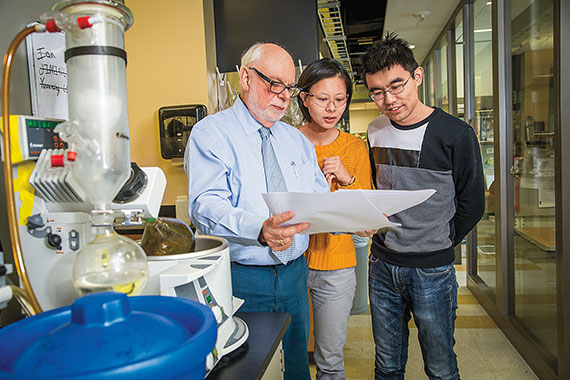
Professor J. Fraser Stoddart, left, meets with doctoral student Xirui Gong, center, and postdoctoral researcher Chuyang Cheng ’16 PhD in Stoddart’s lab on the Evanston campus. Photo by Michael Goss.
At Northwestern, Stoddart holds weekly lab meetings (which he has affectionately dubbed “Group Therapy”) on Saturdays, sometimes combining them with dinner at his home when visiting professors are in town. A generous and gracious host, Stoddart frequently invites students, postdocs and fellow faculty and staff members over for parties and gourmet meals. Often four or five lab members will go over to his house the night before to help Stoddart with shopping and chopping up vegetables for the meal, says his assistant, chemist Peggy Schott.
His specialties include rack of lamb and roasted potatoes with rosemary. Clearly he’s come a long way from the days when he first had to cook for his two young daughters when his wife was out of town. “The first night he cooked potatoes for us, they were half-raw,” remembers Alison. “On the second night he took us to McDonald’s.”
Teaching and mentoring go hand in hand for Stoddart. With more than 28 postdocs and grad students in his lab today, he spends much of his time giving them guidance and editing their papers and presentations.
Though a genial, solicitous and very approachable professor, Stoddart is known as a strict taskmaster when it comes to reviewing the scientific papers and presentations of his lab group. “He demands perfection,” says doctoral student Xirui Gong, who tells of getting papers back completely marked up in red ink.
“Fraser is like a living dictionary of idioms,” says Gong, who is from China. “One time he called my paper ‘a pig’s breakfast’ — which meant it was a messy job!” (See “Fraserisms.”)
“But he supports his students in every way. He’s like a spiritual leader,” adds Gong, who helped proofread The Nature of the Mechanical Bond (Wiley, 2016), the 761-page textbook co-written by Stoddart and Carson Bruns (and published just a few weeks after the Nobel Prize in Chemistry was announced).
“Fraser has been an outstanding mentor of young scientists,” says Will Dichtel, a former postdoc of Stoddart’s at UCLA and now the Robert L. Letsinger Professor of Chemistry at Northwestern. “The way he runs a research group — he sets the tone for the environment, but he’s not a control freak. He gives his students the freedom to pursue new ideas and opportunities, along with guidance on how to tackle the most important problems. Any student in Fraser’s group knows that nothing is going out the door until it is conducted, written and described to the highest standards.”
“Fraser was a great mentor to me,” says Bruns, Miller Research Fellow at the University of California, Berkeley. “He taught me to write — he’s a master of words. He’s not hands-on with the science, but he dedicates his time to teaching his students how to be complete scientists.
“For a person managing 40-plus people in his group at certain times, he was extremely accessible. You could walk into his office whenever you wanted. He was there all the time. No matter how busy he was, he seemed to always have time for you.”
That’s because the professor doesn’t sleep much. He often arrives at the lab by 7 and doesn’t head for home until 8 or 9 in the evening. (See “He’s No Slugabed.”)
“He seems to get most of his sleep in these little power naps,” adds Bruns. “You might find him dozing off in his office or even during meetings and lectures. But he’s the hardest worker I’ve ever met. He’s just up all the time writing emails, doing work. He’ll take any spare moment to do work. Even if he only has five minutes, he’ll pull out a stack of papers and his red pen and start editing.”
Stoddart delights in telling people that his lab members come from all over the world: the United States, China, Italy, Poland, Vietnam, Australia and India, to name a few countries. Moreover, he cites his diverse international lab group as an example of the global aspect of scientific research that is so crucial to discovery today.
The chemist considers his students and postdocs family, so he often attends their weddings when invited, some even as far away as Turkey.
“In my case, he flew to Minneapolis from Chicago and rented a car, which he had to drive on his own for about four hours to reach the little town of Decorah, Iowa, where my fiancée and I got married,” recalls Bruns. “He showed up in his national dress, a kilt, and charmed the pants off of all of our wedding guests!”
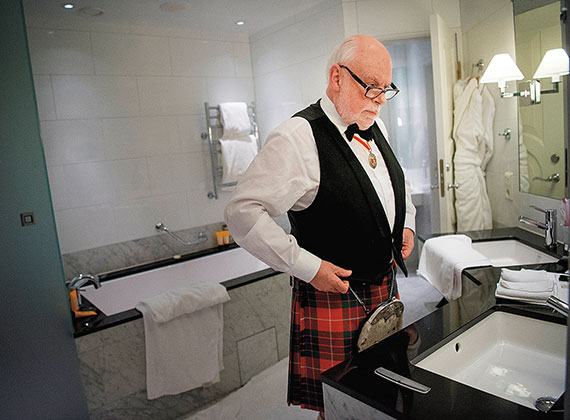
The Scottish-born Nobel laureate dons the Fraser dress kilt before dinner at the Royal Swedish Academy of Sciences. Photo © Nobel Media AB/Alexander Mahmoud.
WHAT’S NEXT?
Most scientists expect a Nobel Prize to bring additional research funding and support to the field in which it is awarded. But Stoddart is more focused on the impact of the prize on future chemists. “I think it’s more about winning over the hearts and minds of young people to encourage them to come into the field (of mechanical bonding and molecular machines),” he says.
Bruns agrees. “The nicest thing about the 2016 Nobel Prize in Chemistry is that the Nobel Committee was very forward about the fact that we now have these molecular machines,” he says. “But it’s not totally clear what they’re going to be useful for. It’s almost like the Nobel Committee is asking people to get into the field and work on it. Here’s this area that needs a lot of development.”
Stoddart plans to continue nurturing the next generation of young chemists and help them find a new big problem to research.
“I’m just orchestrating the big picture. They’re allowed to go off and explore in an almost uninhibited way,” he says of his lab members. “As you go through the decades, you find out (as a professor) that the more you back off, the more productive, both in terms of creativity and in terms of just getting results, the group can become.
“My task is to leave them feeling that what I might have achieved in my life is reachable by them,” Stoddart adds. “You give young people ownership, and they will work miracles.”
As for his own research, Stoddart is not one to rest on his Nobel laurels. He’s exploring options and carrying out collaborations at Northwestern and other academic institutions in the United States and around the globe. One area of keen interest is systems chemistry, the study of complex systems or networks of interacting molecules.
The emerging field of systems chemistry promises to allow such networks to be designed to perform complex functions and could eventually shed light on the origins of life, according to scientists.
Stoddart says he had planned to delve into systems chemistry when he first arrived at Northwestern. For various reasons, however, it didn’t pan out. “But now I think I’ve got a second bite at that cherry,” he says.
Chemistry is said to encompass the richest diversity of all complex systems because it deals with the smallest matter that can be readily manipulated — molecules.
Given the creativity that comes naturally to chemists and, in particular, to the man whose research was inspired by the beauty of intertwining rings and knots in nature and Celtic art, Stoddart’s journey into systems chemistry will likely be fruitful.



 Facebook
Facebook Twitter
Twitter Email
Email


